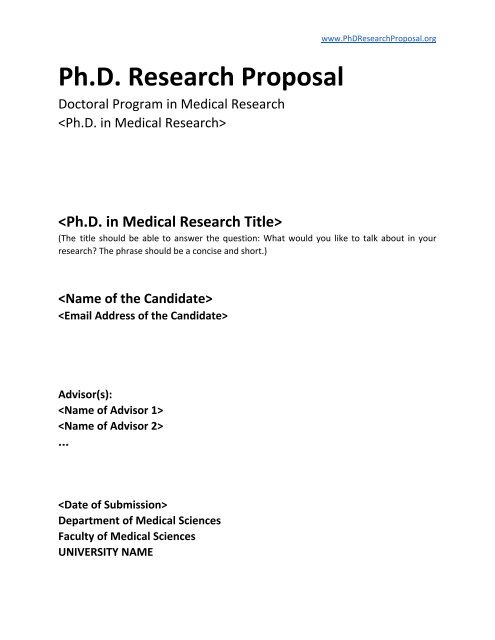PhD Research Proposal Template
Hi! We created special for you this professional PhD research proposal template to show you how it need to look like, if you need to get more details about how to write your PhD research proposal you can visit site https://www.phdresearchproposal.org/how-to-write-a-phd-research-proposal/
Hi! We created special for you this professional PhD research proposal template to show you how it need to look like, if you need to get more details about how to write your PhD research proposal you can visit site https://www.phdresearchproposal.org/how-to-write-a-phd-research-proposal/
Create successful ePaper yourself
Turn your PDF publications into a flip-book with our unique Google optimized e-Paper software.
Ph.D. <strong>Research</strong> <strong>Proposal</strong><br />
Doctoral Program in Medical <strong>Research</strong><br />
<br />
www.<strong>PhD</strong><strong>Research</strong><strong>Proposal</strong>.org<br />
<br />
(The title should be able to answer the question: What would you like to talk about in your<br />
research? The phrase should be a concise and short.)<br />
<br />
<br />
Advisor(s):<br />
<br />
<br />
…<br />
<br />
Department of Medical Sciences<br />
Faculty of Medical Sciences<br />
UNIVERSITY NAME
www.<strong>PhD</strong><strong>Research</strong><strong>Proposal</strong>.org<br />
Abstract<br />
The abstract for this proposal should be able to include the topic, aims of the study, the<br />
participants involved in the mentioned research, the methodologies to be used, and the<br />
timeframe. It is typically concluded using a statement which explains the overall relevance of<br />
the research, and why it is necessary. Abstract for Ph.D. proposals use future tense, as you<br />
outline the things that you intend to do.<br />
This part will also serve as a brief summary to your paper. It should be less than 200 words. The<br />
abstract may start by describing the knowledge domain in which your research takes place, as<br />
well as the key issues involved which may offer opportunities for the technological or scientific<br />
innovations that you are planning to explore. The research statement is then presented, the<br />
proposed methods for research, the results expected to achieve, as well as any anticipated<br />
implications that the results will make regarding the advancement within the knowledge<br />
domain.<br />
Keywords<br />
This portion of your paper includes an alphabetically ordered list which includes the most<br />
common words or expressions that you would be using in a search engine in order to look for a<br />
research proposal that is similar to your work. The list should be up to twelve, separated by<br />
commas.
www.<strong>PhD</strong><strong>Research</strong><strong>Proposal</strong>.org<br />
Table of Contents<br />
CHAPTER 1 Introduction<br />
CHAPTER 2 Literature Review<br />
1.1 Paragraph 1<br />
1. Sub-paragraph 1 of Paragraph 1<br />
2. Sub-paragraph 2 of Paragraph 1<br />
1.2 Paragraph 2<br />
1.1.3 Sub-paragraph 1 of Paragraph 2<br />
1.1.4<br />
Sub-paragraph 2 of Paragraph 2<br />
CHAPTER 3 <strong>Research</strong> Objectives and Methodology<br />
CHAPTER 4 Current Work & Initial Results<br />
CHAPTER 5 Work Plan and Potential Implications<br />
CHAPTER 6 Conclusion<br />
References
www.<strong>PhD</strong><strong>Research</strong><strong>Proposal</strong>.org<br />
CHAPTER 1<br />
Introduction<br />
In some paper proposals, a background is also presented aside from the introduction, and they<br />
are separate. In other papers, both serve the same purpose and are being combined. Both<br />
sections outline the reason why you have selected the topic.<br />
The introduction part provides an overview of the research project being proposed to carry out.<br />
It provides an explanation on the project background, briefly focusing on the primary issues<br />
within the knowledge domain, giving clarification to the reason why the issues presented are<br />
worth the attention. Afterwards, presents the research statement concisely, possibly taking the<br />
form of a research question, hypothesis, goal statement, or a project statement.<br />
The research statement needs to capture both the essence and the limitations of the project,<br />
followed by a clarification on the expected outcomes, representing an advancement in the<br />
knowledge domain presented. Right from the start, the introduction should focus on catching<br />
the interest of the reader, thus being written in a style which could be easily understood by any<br />
reader having a general background. It should be able to cite all pertinent references referring<br />
to the described major issues, closing with a brief description of every chapter included.<br />
A lot of research proposal authors prefer postponing writing their introduction until the entire<br />
document is completed. This makes sense, given the fact that writing has the tendency to<br />
introduce a lot of changes in the initially sketched plans by the writer, which means that it is<br />
only during that time that the whole document is completed that the writer gets a clearer view<br />
on how the introduction can be instructed in a compelling way.<br />
CHAPTER 2<br />
Literature Review<br />
The Literature Review serves as a cluster which presents very important aims of the study. For<br />
one, it shows that you have created a solid knowledge in the field wherein the research takes<br />
place, showing your familiarity with the primary issues at hand, and that you have identified<br />
critically, and assessed the key literature used.
www.<strong>PhD</strong><strong>Research</strong><strong>Proposal</strong>.org<br />
On the other hand, this portion also shows that you have established a coherent and innovative<br />
view in synthesizing and integrating the primary aspects in the field, so that you can now finally<br />
put into perspective the new directions that you are planning to explore. This part should also<br />
provide credit to the authors who are laying the groundwork for the research. By doing so, in<br />
the following chapter, the research objects are clarified further, so that the reader can<br />
recognize beyond doubt that when you attempt doing something which has not been done<br />
previously, and that your research will most likely a significant contribution to the specific<br />
literature used.<br />
The Literature Review is typically the most extensive portion of a research proposal. It will be<br />
expected to be developed over a number of paragraphs and sub-paragraphs. It needs to be<br />
accompanied by a number of well-prepared references, listed towards the end of your<br />
proposal. Ideally, as with other authoritative books, papers, book chapters, and other<br />
professional texts produced within the knowledge domain that you are working on, your paper<br />
need to be mentioned and listed towards the end of your proposal. It is also important to<br />
follow the appropriate referencing syntax appropriately.<br />
The options on referencing conventions may actually depend on the particular field of the<br />
location of your research. Among the popular conventions established include the American<br />
Psychological Association (APA), Institute of Electrical and Electronics Engineers (IEEE),<br />
Association for Information Systems (AIS), and the Association for Computing Machinery (ACM).<br />
1.1 Paragraph 1<br />
1.1.1 Sub-paragraph 1 of Paragraph 1<br />
Since the Literature Review part is most likely to extend to several pages, it may have to be<br />
divided into different paragraphs, equipped with its own titles, with the paragraphs further<br />
broken up into sub-paragraphs. These should comply with the format presented.<br />
1.1.2 Sub-paragraph 2 of Paragraph 1<br />
An example of the second sub-paragraph for the introduction’s first paragraph.<br />
1.2 Paragraph 2<br />
1.1.3 Sub-paragraph 1 of Paragraph 2<br />
An example of the first sub-paragraph for the introduction’s second paragraph.
www.<strong>PhD</strong><strong>Research</strong><strong>Proposal</strong>.org<br />
1.1.4 Sub-paragraph 2 of Paragraph 2<br />
An example of the second sub-paragraph for the introduction’s second paragraph.<br />
CHAPTER 3<br />
<strong>Research</strong> Objectives and Methodology<br />
This chapter clarifies the objective of research for your project, considering it as a background<br />
of your description of the literature review, and describing the methods you are planning to use<br />
in order to deal with the main research challenges involved. The clarification of your research<br />
objective should be solidly founded on the Literature Review, and relate your work on the other<br />
studies performed by others.<br />
CHAPTER 4<br />
Current Work & Initial Results<br />
This chapter will provide a concise and brief outline of the study you have conducted so far, as<br />
well as the progress that you have already made towards the project aims. You need to<br />
concentrate on the portions which specifically contribute towards the goals of your project.<br />
Avoiding those detailed explanations should also be taken into mind. If you have already<br />
completed some preliminary results, this is the portion where these should be highlighted in a<br />
well-structured manner which actually helps in supporting the rest of your proposal.<br />
CHAPTER 5<br />
Work Plan and Potential Implications<br />
Not all completed research proposals easily lend themselves to the creation of accurately made<br />
work plans. In certain cases, especially when the work fits the wider plans of a research group<br />
that is steadily progressing, it is highly possible to create a detailed description of what your<br />
researcher is planning to do.
www.<strong>PhD</strong><strong>Research</strong><strong>Proposal</strong>.org<br />
In these specific cases, if it is desirable and possible, to establish certain timelines and<br />
milestones, as well as a Gantt Diagram. The plan needs to anticipate the potential problems<br />
which would likely to be found, describing the methods to be followed when it comes to solving<br />
them. It should also provide an anticipation to the journals and conferences with which the<br />
work is expected to be completed along the way, as well as the schedule to be anticipated.<br />
In other scenarios, when the topic that you are planning to research is elusive and exploratory,<br />
or when your research approach emphasizes that every step should be based on the currently<br />
unanticipated results of the previous steps, it may turn out to be impossible to complete a<br />
detailed plan. However, even in these cases, it is highly advisable to create a section which will<br />
present the Goals for Publications, giving a rough estimate of the schedule for the produced<br />
publications. Despite its contingency, the list may perform great things when it comes to<br />
ensuring that you stay motivated, focused and beneficial even under pressure.<br />
Regardless of the nature of your work plan, whether it is sketchy or a comprehensive study, it<br />
should put into perspective all the implications which are involved for the success in your work,<br />
emphasizing on the mind of the reader, the belief that your approach is oriented solidly<br />
towards the results, and that the topic is relevant and timely, and that the outcome of this<br />
research project will significantly contribute towards the enhancement of the field.<br />
CHAPTER 6<br />
Conclusion<br />
The conclusions part should briefly present the objectives for your research project, recapping<br />
the methods for research that you are planning to follow, and briefly clarifying in just a few<br />
rods, what you are expecting to find out, the reason why it is scientifically important to find it<br />
out, and your basis of expected evaluation on the validity of the results.<br />
References<br />
In this chapter, all of the references that you have used for the entire research proposal should<br />
be listed accordingly, ensuring that you are complying with the required citation styles or<br />
referencing conventions which have been established accordingly for your specific field.







